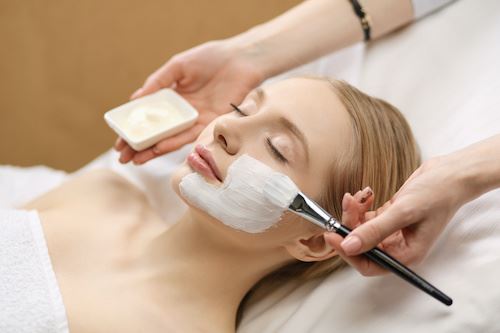
Nowadays there are plenty of companies, products and treatments that guarantee you will look younger in a certain amount of time. With so many different options available to you, and the vast amount of information available, it’s understandably difficult to know what treatment option is the best. This article from the Journal of the American Academy of Dermatology outlines the science behind chemical peels and how the process has evolved over the last several decades.
You may have heard about a chemical peel treatment being a viable option for making your skin look brighter, healthier and younger in a short amount of time. The results and chemical peel benefits speak for themselves, but before you object to or jump into getting a chemical peel treatment, be sure to understand the facts of how it works so you can make an informed decision about your skin care options.
How A Chemical Peel Treatment Works
In basic terms, a chemical peel is a process where an acid chemical solution is used to create an exfoliation process to remove old layers of skin and reveal new layers of skin underneath. The secret is in the mixture of ingredients:
- Glutathione - an antioxidant designed to neutralize the harmful effects of free radicals in the skin and slow the aging process.
- Kojic Acid - lightens the skin and tightens it by increasing elastin and collagen production.
- TCA, Retinoic and Phenol Acid - resolves pigmentation issues and helps reduce skin wrinkles.
- Salicylic Acid - improves inflammation and exfoliates the outer layer of skin.
These ingredients work together to improve the texture and tone of your skin, improve pore size, revise skin blemishes and much more. Once a medical professional applies the chemical peel to your skin, the process begins immediately. You should notice the peeling process beginning about three days after the application and could take up to 12 days to see all of the chemical peel benefits.
Types of Chemical Peels Available
There are three main types of chemical peels available today:
- Superficial Peel - this type of chemical peel treats the outermost layer of skin by creating a gentle exfoliation process.
- Medium Peel - this type targets both the outer and middle layers of skin to improve more severely-damaged skin cells.
- Deep Peel - this type of peel is rarely used today since laser skin resurfacing treatments are more effective and cause fewer side effects.
Your medical professional will evaluate your skin thoroughly and help you determine which type of chemical peel treatment is right for you based on your condition and overall health.
Suitable Candidates For Chemical Peels
The great thing about a chemical peel for acne is all skin types can be treated. However, it’s important to note that you are not a suitable candidate if you:
- Have any open wounds, sunburn or skin infections
- Recently underwent or are undergoing electrolysis treatments, chemotherapy or radiation
- Have a history of autoimmune disease or related conditions
- Are currently pregnant or breastfeeding
- Are allergic to any of the chemicals used in the peel
Potential Side Effects Following Treatments
Having proper expectations going into your chemical peel treatment will make the results seem more realistic. While there typically aren’t any major adverse side effects, the University of Wisconsin-Madison, School of Medicine and Public Health indicates you could experience side effects like skin redness, irritation, sensitivity, itching and more.
You can resume normal activities immediately after getting the chemical peel administered, but it’s advisable to refrain from doing heavy exercising or participating in activities where you will sweat. And arguably one of the most important tips is to stay out of the sun as much as possible and wear sunblock during the peeling process. Your skin will be more vulnerable to getting burned in the sunlight after getting a chemical peel. You can prevent permanent damage to your skin by taking these precautions.
Professionally-Administered Chemical Peels Are More Effective
Some of the biggest myths and misconceptions about chemical peels come from people reading online and hearing about people who have had poor experiences. Chances are these poor experiences result from people using over-the-counter chemical peel applications rather than relying on a qualified medical professional. You can save money by purchasing over-the-counter applications, but they will not be nearly as effective and you could cause long-term, permanent damage to your skin if not applied properly.
Always opt for a professionally-administered chemical peel since it will be more effective and safer. The process typically takes no longer than 30 minutes to administer and you can go back to work immediately after it is applied. Your medical professional can also recommend topical ointments to relieve any discomfort and will follow-up with you if you are experiencing any unusual side effects. Most people will need multiple treatments spread out over four or five weeks, depending on the recommendation of your medical professional.
Skin Deep Laser Services has plenty of examples of chemical peel benefits from our clients over the years. We evaluate each of our clients thoroughly to determine whether a chemical peel is right for them or if another treatment option will help them reach their skin care goals. Understanding the facts about chemical peels can help you make an informed decision about whether you want to proceed. Our medical professionals are always available to answer questions, so contact us today to get the conversation started.


